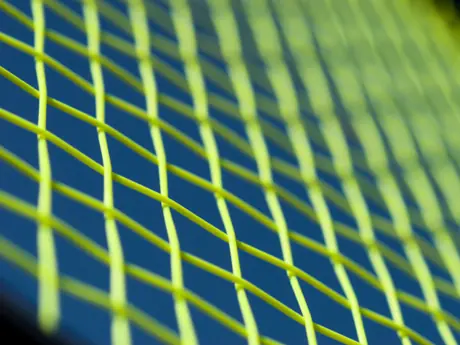If you are an avid tennis player or follow the sport in detail, you might have come across terms such as “string pattern” and “string tension.” I’ll admit, when I started in the game I assumed that all rackets were strung the same way, the only difference perhaps being how tight the racket was strung. How wrong was I! There are many ways to string a racket and as you develop your game it will be important to understand which one suits you best.
So what do people mean when they talk about different string patterns? What impact does a string pattern have on your tennis game? In this article, we’ll be discussing tennis racket string patterns in detail. From the most common string patterns and their effect on the game to what the pros use and how to choose the best string pattern to suit your style – we’ve got you covered!
What is a Racket String Pattern?
First things first, let’s understand what a string pattern is. The string pattern of a racket refers to the way the strings are arranged on the racket head. Racket manufacturers typically provide a string pattern measurement, which tells you the number of main and cross strings present on the racket head. For instance, a common string pattern is 16 x 19, which means there are 16 main strings and 19 cross strings. Simply put, the string pattern determines the number of strings that come in contact with the ball.

How Does a String Pattern Affect a Tennis Racket?
Now that you know what a string pattern is, let’s move on to how it affects your racket and play. A string pattern affects the feel and performance of your racket. A denser string pattern will provide better control over the ball, while a looser string pattern will generate more power. A denser string pattern also offers greater spin potential, as it allows you to generate more revolutions on the ball. On the other hand, a looser string pattern may reduce the durability of strings as they rub against each other, resulting in quicker string breakage.
Most Common String Patterns:
Let’s take a look at some of the most common string patterns you’ll come across:
The 16 x 19 Racket String Pattern: Pros and Cons
The 16 x 19 string pattern is probably the most common formation, offering a good balance between control and power, and is favored by many professional players. Let’s delve a little deeper into its benefits and drawbacks.
Pros
- Versatility: The 16 x 19 pattern is a versatile configuration that will suit players of most skill levels, making it a great choice whether you’re a beginner or a seasoned pro.
- Spin Potential: This pattern allows for greater spin potential as the wider spacing between the strings allows for more ball bite, resulting in more revolutions per minute on ball contact.
- Power: The wider gaps between the strings in a 16 x 19 pattern allow the ball to sink deeper into the string bed, storing more energy that is released upon ball impact, generating more power.
Cons
- Durability: A downside of a 16 x 19 string pattern is that the strings may wear out faster due to increased friction from the wider spacing. This is particularly true if you’re a hard hitter or frequent string breaker.
- Control: While the 16 x 19 pattern does allow for control, it may not be as precise as denser string patterns, which offer more surface area for ball contact, giving players more control over their shots.
The 16 x 20 Racket String Pattern: Pros and Cons
The 16 x 20 string pattern is another popular formation, widely recognized for its unique blend of control, spin, and power.
Pros
- Enhanced Control: The 16 x 20 string pattern, having denser strings, provides increased control over the shots. The additional string at the racket’s sweet spot grants more precision, making it ideal for players who value placement over power.
- Improved Durability: The closer string arrangement results in less friction between strings, hence increasing the string’s lifespan. This pattern is a suitable choice for aggressive players who often hit hard shots.
- Balanced Spin and Power: Despite the denser pattern, it still offers a good degree of spin potential and power. The string-cradling effect that this pattern provides enhances the power, making it a balanced choice for various playing styles.
Cons
- Reduced Spin Potential: While the 16 x 20 pattern offers a decent amount of spin, it may not match up to the higher spin potential provided by more open string patterns like the 16 x 19.
- Comfort: The increased string density can lead to a stiffer string bed, which may not be as comfortable for some players, particularly those who are prone to arm injuries or discomfort.
- Power: Although it offers balanced power, players who prefer more explosive power shots may find the 16 x 20 pattern slightly less powerful compared to open string patterns.
The 18 x 20 Racket String Pattern: Pros and Cons
The 18 x 20 string pattern is considered a denser formation, revered for its superior control and durability but with potential downsides in power and spin.
Pros
- Supreme Control: With the highest density among common string patterns, the 18 x 20 setup offers unmatched control over the shots. It’s a popular choice among advanced players who prioritize precision.
- Exceptional Durability: The closely packed strings result in reduced wear and tear, increasing the string’s lifespan. This factor makes the 18 x 20 pattern ideal for players who engage in long, aggressive matches.
- Stability: This string pattern provides a stable response on hits, contributing to its high level of control and consistency across different shots.
Cons
- Spin Potential: As the string pattern becomes denser, it naturally limits the space for the ball to embed into the string bed, thereby reducing spin potential. Players who rely heavily on spin-based tactics might find the 18 x 20 pattern less suitable.
- Power: The dense pattern creates a firmer string bed, which could limit the power output. Players who enjoy delivering powerful shots might feel restricted.
- Comfort: Similar to the 16 x 20 pattern, the 18 x 20 pattern might feel stiffer, potentially leading to discomfort, especially for players with a history of arm injuries.
The 16 x 18 Racket String Pattern: Pros and Cons
The 16 x 18 string pattern is a blend of power and control, offering a balanced performance for a broad range of players.
Pros
- Balance of Power and Control: This string pattern strikes a balance with its denser string formation than open string patterns, yet provides more power than the 18 x 20 pattern. It suits players wanting a blend of power and control in their play.
- Moderate Spin Potential: The 16 x 18 pattern offers more spin potential than the 18 x 20 pattern due to the larger space for ball embedment in the string bed. This makes it an ideal choice for players who use spin in their shot-making.
- Durability: The 16 x 18 string pattern provides a level of durability that falls between the open string patterns and the denser 18 x 20 pattern, offering more string life than open patterns.
Cons
- Less Control Than 18 x 20: While offering control, the 16 x 18 pattern may not satisfy players who prioritize precision and supreme control, as the 18 x 20 pattern does.
- Less Powerful than Open Patterns: The denser formation of the 16 x 18 pattern may not provide as much power as open string patterns, making it less suitable for players who focus on power shots.
- Comfort: As with denser string patterns, the 16 x 18 could feel stiffer and potentially cause discomfort, particularly for players prone to arm injuries.
Other String Patterns:
Apart from these commonly used string patterns, there are other patterns such as 14 x 18 and 18 x 16. These patterns are typically used by advanced players who have a specific style of play. A 14 x 18 pattern, for instance, provides excellent spin potential but can be challenging to use. An 18 x 16 pattern generates more power but may offer less control.
What String Patterns Do The Pros Use?
Professional players often customize their racket string pattern to suit their specific style of play. For instance, the 16×19 string pattern is a popular choice among many professional tennis players, including Roger Federer and Rafael Nadal. Novak Djokovic, Serena Williams, and Daniil Medvedev are known to use the 18×19 pattern, while Alexander Zverev prefers the 18×20 pattern on his racket.
What is the Best String Pattern for me?
Choosing the right string pattern ultimately depends on your playing style. If you prefer a balance between power and control, a 16 x 19 pattern may be ideal for you.
If you’re looking for more control, an 18 x 20 pattern may be a better fit. Similarly, if you need more power, a 16 x 18 pattern may suit you better.
It is also essential to consider your skill level and the type of court you’ll be playing on – clay courts may require a different string pattern compared to hard courts for example.
Who Strings Tennis Rackets?
Unless you have experience doing this, you will need to find a coach to advice and string a racket for you. I take all my rackets to my club to be restrung. Here I know the racket is in good hands and all rackets have the same tension / look and feel. If I did it myself it would be a disaster! Watch the below to see an interview with Roger Federer’s professional stringer.
Meet the man who strings Roger Federer’s rackets – YouTube
Frequently asked questions:
Does a string pattern affect the durability of strings?
Yes, a denser string pattern may cause strings to rub against each other, resulting in quicker breakage.
Should I use a looser or denser string pattern?
Choosing a string pattern depends on your playing style and skill level. A looser pattern generates more power, while a denser pattern provides better control.
How can I tell the string pattern of my racket?
The string pattern measurement is typically provided by the manufacturer. You can also count the number of strings present on your racket head.

Final thoughts:
Choosing the right string pattern can make a significant difference in your game. While there are many options available, it’s crucial to consider your playing style, skill level, and court surface before making a decision.
When I was learning to play I played with a more open string pattern (16×19) and as my game developed I experimented with new patterns. I play a serve and volley game so now play with a 16 x 20 natural gut string. This gives me more control over my volleys and as my fellow players will tell you, I never really had any power!
Experiment with different string patterns to find the one that works best for you, and don’t hesitate to consult with a tennis coach or stringer for advice. With the right string pattern, you’ll be able to improve your game and enjoy playing tennis even more!






Comments are closed.